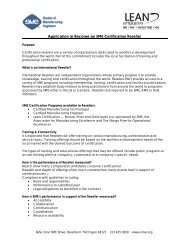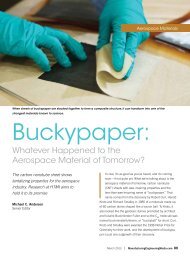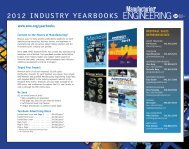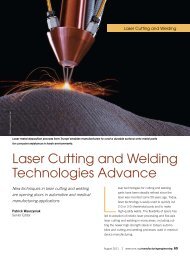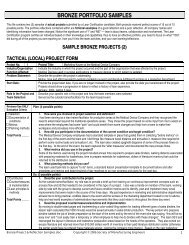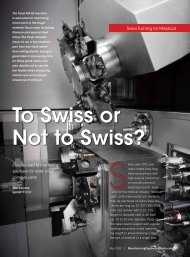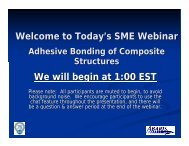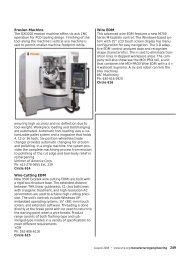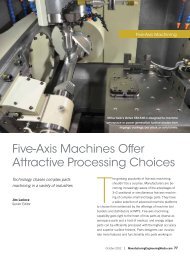The RAPID 2013 Conference & Exposition Directory - Society of ...
The RAPID 2013 Conference & Exposition Directory - Society of ...
The RAPID 2013 Conference & Exposition Directory - Society of ...
You also want an ePaper? Increase the reach of your titles
YUMPU automatically turns print PDFs into web optimized ePapers that Google loves.
2:30–2:55 pm<br />
Additive Manufactured Modular Telescoping<br />
Wing Unmanned Aerial Vehicle<br />
Michael Stern, Rapid Prototyping Engineer, MIT Lincoln Laboratory<br />
Eli Cohen, UAV Test Engineer, MIT Lincoln Laboratory<br />
We present a low-cost, highly flexible and modular Unmanned<br />
Aerial Vehicle (UAV) for atmospheric sensing. A novel<br />
aerodynamic design was realized with a lightweight, efficient<br />
mechanical structure designed for and fabricated with additive<br />
manufacturing (AM) to meet performance requirements. <strong>The</strong><br />
aerodynamic design features telescoping wings to permit both<br />
dash and loiter flight depending on the exposed wing area<br />
and airfoil. <strong>The</strong> aircraft structure is primarily Fused Deposition<br />
Modeling (FDM) ABS-M30 with supplemental carbon fiber. <strong>The</strong><br />
total weight <strong>of</strong> the aircraft was seven pounds with a wing span<br />
<strong>of</strong> 80". We designed the structure to be easily assembled using<br />
only standard hand tools. <strong>The</strong> modular design permits rapid<br />
reconfiguration <strong>of</strong> the aircraft and the ability to swap payloads<br />
while simplifying replacement <strong>of</strong> damaged parts, even in the field.<br />
Focus on frangible design prevents widespread damage and<br />
minimizes rebuild in the case <strong>of</strong> failure. We completed several<br />
test flights demonstrating the structural integrity <strong>of</strong> the AM parts<br />
and the success <strong>of</strong> the overall design.<br />
This work is sponsored by the Air Force under Air Force contract<br />
number FA8721-05-C-0002. <strong>The</strong> opinions, interpretations,<br />
recommendations, and conclusions are those <strong>of</strong> the authors and<br />
are not necessarily endorsed by the United States Government.<br />
3–3:25 pm<br />
Global Advances in Metal Additive Manufacturing<br />
for Final Part Production<br />
Tim Caffrey, BS, Associate Consultant, Wohlers Associates<br />
Applications for metal parts built by additive manufacturing<br />
have developed quickly in the decade or so since metal AM was<br />
introduced. <strong>The</strong> technology for the production <strong>of</strong> parts that go<br />
into final products is also growing at a fast pace. Caffrey will<br />
discuss materials, processes, systems, and current applications<br />
for final part production in the aerospace, medical, dental, and<br />
jewelry industries around the world. <strong>The</strong> presentation will also<br />
cover the current and future challenges <strong>of</strong> manufacturing with<br />
metal AM processes.<br />
3:30–3:55 pm<br />
Additive Manufacturing—A Critical Review<br />
Walter J. McGee, FIAE, Sr. Design Check Engineer II,<br />
Raytheon Space & Airborne Systems<br />
In evaluating the potential <strong>of</strong> AM and MBD as the wave <strong>of</strong> the<br />
future, it is vital that adequate attention be given to both the<br />
benefits and challenges these technologies present. <strong>The</strong>se<br />
technologies <strong>of</strong>fer the possibility <strong>of</strong> paperless engineering and<br />
more cost effective manufacturing <strong>of</strong> complex or small quantity<br />
parts. However, along with the significant savings potential,<br />
these technologies raise some important questions. For example,<br />
are new methods/equipment needed to accurately measure the<br />
size and shape <strong>of</strong> more complex geometries? What changes are<br />
needed to qualify AM materials and processes to allow broader<br />
use in prime hardware? How should paperless companies<br />
prepare for a natural or terrorist event that could destroy<br />
electronic technical data?<br />
This report will consider a few <strong>of</strong> the questions that should<br />
be asked when weighing the costs/benefits <strong>of</strong> adopting these<br />
new technologies.<br />
4–4:25 pm<br />
Sustainable Cars and the Future <strong>of</strong> Manufacturing<br />
Jim Kor, P.Eng., President, KOR EcoLogic<br />
For URBEE 2, KOR EcoLogic has made a mental leap. <strong>The</strong>y are now<br />
designing the car so that the major body and interior parts (about<br />
40 to 50 parts in total) MUST be made by the 3D printing process.<br />
No other process will be able to make parts as complicated as<br />
they plan to design. This is quite different than rapid prototyping<br />
a few parts. This designing exclusively for 3D printers has<br />
been termed Digital Manufacturing. KOR EcoLogic expects to<br />
manufacture these parts in a “factory <strong>of</strong> the future” that houses<br />
many 3D printers, all mass producing production parts.<br />
6/<strong>2013</strong> – <strong>RAPID</strong> 41





